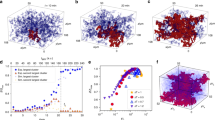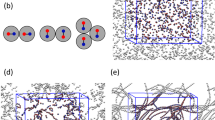Abstract
The morphology and structure factor of a 2D system of particles interacting through a Lennard-Jones potential, modified to include a long-range repulsive component, are described. Of particular interest are those systems quenched from a stabilized colloidal state to temperatures that, in the pure Lennard-Jones system, correspond to the solid-vapor coexistence region. We find that competition between the short-range attractive forces—which cause aggregation—and the long-range repulsion—which acts to keep the particles apart—encourages the formation of space-filling networks. A characteristic peak in the structure factor is observed which moves toward lower wavevectors as the simulation evolves. However, unlike the pure Lennard-Jones system, which when given enough time will completely phase separate, this peak stops moving once a network has formed. The similarities between our simulations and gel formation are discussed.
Similar content being viewed by others
References
1._B.D. Butler, H.J.M. Hanley, D. Hansen, and D.J. Evans, Phys. Rev. B 53, 2450 (1996); B.D. Butler, H.J.M. Hanley, D. Hansen, and D.J. Evans, Phys. Rev. Lett. 74, 4468 (1995).
J. Felicity, M. Lodge, and D.M. Heyes, J. Chem. Soc. Faraday Trans. 93, 437 (1997).
J.F.M. Lodge and D.M. Heyes, Phys. Chem. Liq. 31, 209 (1996).
M.T.A. Bos and J.H.J. van Opheusden, Phys. Rev. E 53, 5044 (1996); B.H. Bijsterbosch, M.T.A. Bos, E. Dickinson, J.H.J. van Opheusden, and P. Walstra, Faraday Discuss. 101, 51 (1995).
D.W. Schaefer, J.E. Martin, P. Wiltzius, and D.S. Cannell, Phys. Rev. Lett. 52, 2371 (1984); G. Dietler, C. Aubert, D.S. Cannell, and P. Wiltzius, Phys. Rev. Lett. 57, 3117 (1986); J.E. Martin and A.J. Hurd, J. Appl. Cryst. 20, 61 (1987).
M. Carpineti and M. Giglio, Phys. Rev. Lett 68, 3327 (1992).
B.D. Butler, C.D. Muzny, and H.J.M. Hanley, J. Phys. Condens. Matter 8, 9457 (1996); B.D. Butler, C.D. Muzny, and H.J.M. Hanley, Int. J. Thermophysics 20, 35 (1999).
W.C.K. Poon, A.D. Pirie, and P.N. Pusey, Faraday Discuss 101, 65 (1995).
D.J. Robinson and J.C. Earnshaw, Phys. Rev. Lett. 71, 715 (1993).
B.D. Butler and T.R. Welberry, J. Appl. Cryst. 25, 391 (1992).
H. Huang, C. Oh, and C.M. Sorensen, Phys. Rev. E 57, 875 (1998).
A. Hasmy, M. Foret, E. Anglaret, J. Pelous, R. Vacher, and R. Jullien, J. Non-Cryst. Solids 186, 118 (1995).
F. Sciortino and P. Tartaglia, Phys. Rev. Lett. 74, 282 (1995).
M.D. Haw, W.C.K. Poon, and P.N. Pusey, Phys. Rev. E 56, 1918 (1997).
Author information
Authors and Affiliations
Rights and permissions
About this article
Cite this article
Butler, B., Hanley, H. Aggregation in Quenched Systems Interacting through a Short-Range Attractive, Long-Range Repulsive Potential. Journal of Sol-Gel Science and Technology 15, 161–166 (1999). https://doi.org/10.1023/A:1008791522737
Issue Date:
DOI: https://doi.org/10.1023/A:1008791522737




